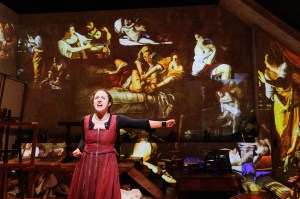Collective Rage: A Play in 5 Betties Builds the Wall Just to Knock It Down Again
Jen Silverman’s new ensemble play makes its off-Broadway debut at MCC.
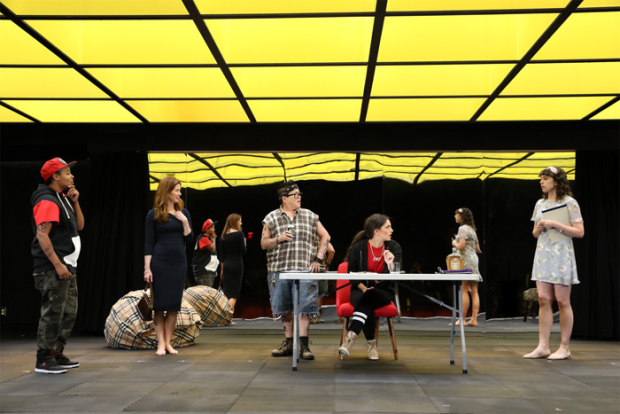
(© Joan Marcus)
"Everybody has a p*ssy," says Betty 4 (Lea DeLaria as a paradigmatically butch lesbian who spends all of her time working on her truck), to Betty 2 (Adina Verson, tying herself in knots as a wealthy housewife who's too afraid to even peek…down there). It's a telling turn of phrase that seems at first comically false, and then incisively true — at least in playwright Jen Silverman's slanted version of reality where names are irrelevant and everyone's a lonely, lost, and pissed-off Betty.
Collective Rage: A Play in 5 Betties, now running at MCC's Lucille Lortel Theatre, is an indefinable creature that knows exactly what it is — a rare breed that leaves you with the best combination of befuddlement, curiosity, and delight. Props fall from the sky (through set designer Dane Laffrey's central grid of yellow light), long-winded captions demarcate scenes (projections designed by Caite Hevner), and inanimate objects animate in the strangest of moments. The only rule of Collective Rage is there are no rules. And yet, throughout the loosely plotted, amorphous concoction of a story, Silverman and director Mike Donahue confidently guide us through the simultaneous creation and destruction of the metaphorical boxes in which our five Betties live.
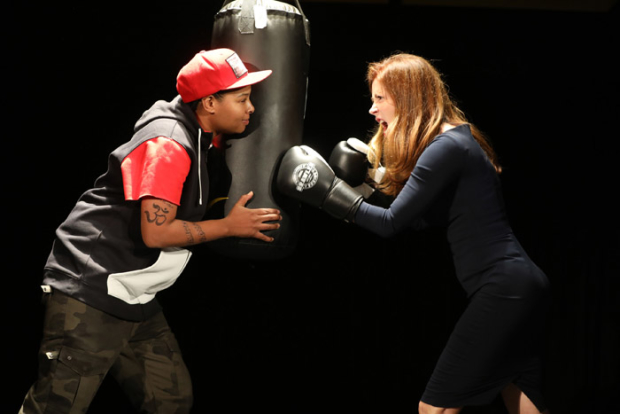
(© Joan Marcus)
We first meet Betty 1 (Dana Delany) — a rich white woman in a sexy-but-conservative black dress fit for outings to church or the country club (costumes by Dede Ayite) — who monologues about frightening news headlines and bemoans the apathetic response by her suit-wearing husband, Richard. She finds new pieces of herself in her attraction to Betty 5 (a swaggering Chaunté Wayans), a "non-conforming masculine-presenting female-bodied individual" who allows Betty 1 to release her bottled-up rage at a boxing gym (Delany's expels her anger in satisfying primal screams). Despite her particularity about her own labels, Betty 5 ascribes to the impersonal sexual philosophy, "P*ssy is p*ssy. You don't gotta name it" (if you have an aversion to that word, this is not the play for you). Then you have the uninhibited Betty 3 (Ana Villafañe), who, while also extremely vocal about her sex life, cares less about gender and sexuality labels than her developing identity as a playwright, director, actor, and fledgling celebrity.
In a bizarre but tickling narrative turn, the plot ends up hinging on Betty 3's "devised theater" production of Pyramus and Thisbe (the play-within-a-play from Midsummer Night's Dream, which Silverman uses as a nod to her own silly play-within-a-play). Betty 3 can't always remember the name of the play she's putting on, but she will certainly be portraying its two title characters and divvies up the roles of Moonshine, Lion, Prologue, and Wall among the remaining Betties (Betties 4 and 5 find themselves vying for the coveted role of Wall, which they decide holds untapped potential).
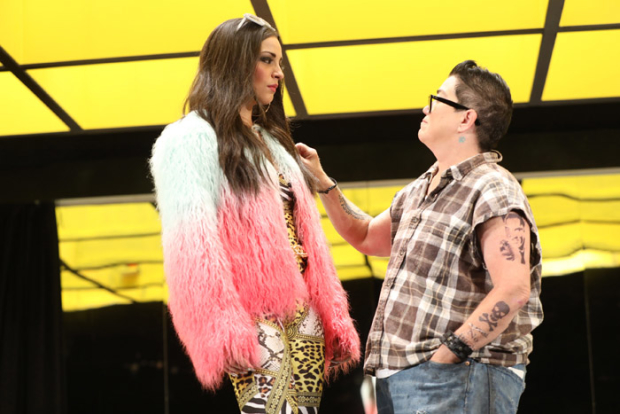
(© Joan Marcus)
Betty 3 embodies every cliché of the self-branded vlogging auteur, but Villafañe calibrates her character's fast-talking naïveté with just enough exposed desperation for love and admiration that you almost want to subscribe to her YouTube channel, just to give her a fix of affirmation. Her scenes with DeLaria, whose Betty carries the sincerest and sweetest of torches for the blossoming drama queen, draws a satisfying honesty out of both sides, proving that while each of these Betties may be an exaggeration, she is never a punchline. Delany and Wayans are equally delightful to watch in their growing chemistry as the infatuated Betties 1 and 5, who, together, pummel (literally and figuratively) the very image of a suit-wearing "Richard."
And then there was Betty 2.
Verson, delivering the show's standout performance, walks her Betty's winding road with reckless abandon while taking perhaps the farthest journey of all the women. Starting in the most pitiable of states, she makes the oddest but most miraculous transformation from a mouse into a literal lion (her character in the Shakespeare adjacent production and an amusing nod to all her p*ssy talk), all precipitated by a transcendent moment with a hand mirror.
Each of the five women embrace their theatrical characters, gaining inspiration from their assigned roles to seize what (and who) they want, while also subverting the expectations that accompany those titles. Throughout Collective Rage, names are a glaring presence and conspicuous void — a mode of claiming space and a tool to blend into the scenery. The implications of that are to debate after the show, but at the very least you'll be left with the wisdom that even if you've been assigned the role of Wall, nothing is stopping you from delivering a romantic soliloquy.
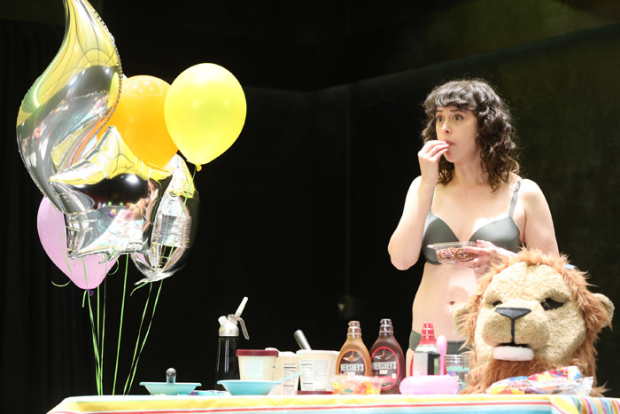
(© Joan Marcus)







